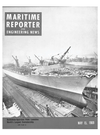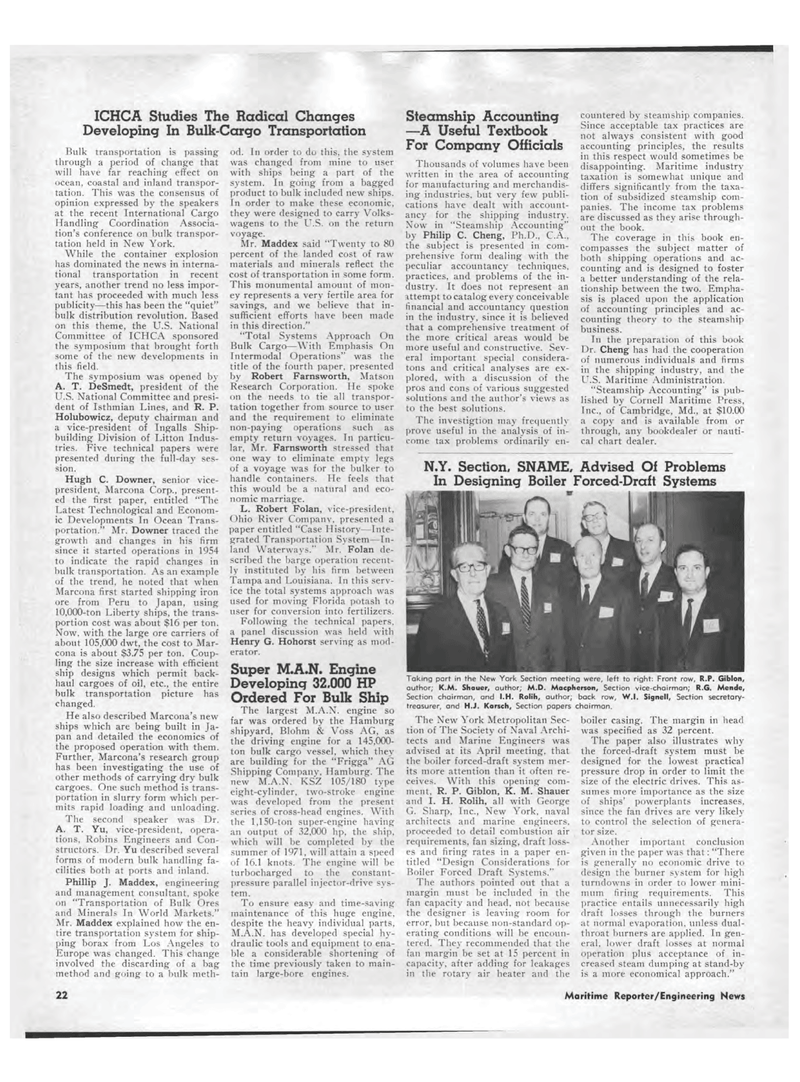
Page 20: of Maritime Reporter Magazine (May 15, 1969)
Read this page in Pdf, Flash or Html5 edition of May 15, 1969 Maritime Reporter Magazine
ICHCA Studies The Radical Changes Developing In Bulk-Cargo Transportation Bulk transportation is passing through a period of change that will have far reaching effect on ocean, coastal and inland transpor-tation. This was the consensus of opinion expressed by the speakers at the recent International Cargo Handling Coordination Associa-tion's conference on bulk transpor-tation held in New York. While the container explosion has dominated the news in interna-tional transportation in recent years, another trend no less impor-tant has proceeded with much less publicity?this has been the "quiet" bulk distribution revolution. Based on this theme, the U.S. National Committee of ICHCA sponsored the symposium that brought forth some of the new developments in this field. The symposium was opened by A. T. DeSmedt, president of the U.S. National Committee and presi-dent of Isthmian Lines, and R. P. Holubowicz, deputy chairman and a vice-president of Ingalls Ship-building Division of Litton Indus-tries. Five technical papers were presented during the full-day ses-sion. Hugh C. Downer, senior vice-president, Marcona Corp., present-ed the first paper, entitled "The Latest Technological and Econom-ic Developments In Ocean Trans-portation." Mr. Downer traced the growth and changes in his firm since it started operations in 1954 to indicate the rapid changes in bulk transportation. As an example of the trend, he noted that when Marcona first started shipping iron ore from Peru to Japan, using 10,000-ton Liberty ships, the trans-portion cost was about $16 per ton. Now, with the large ore carriers of about 105,000 dwt, the cost to Mar-cona is about $3.75 per ton. Coup-ling the size increase with efficient ship designs which permit back-haul cargoes of oil, etc., the entire bulk transportation picture has changed. He also described Marcona's new ships which are being built in Ja-pan and detailed the economics of the proposed operation with them. Further, Marcona's research group has been investigating the use of other methods of carrying dry bulk cargoes. One such method is trans-portation in slurry form which per-mits rapid loading and unloading. The second speaker was Dr. A. T. Yu, vice-president, opera-tions, Robins Engineers and Con-structors. Dr. Yu described several forms of modern bulk handling fa-cilities both at ports and inland. Phillip J. Maddex, engineering and management consultant, spoke on "Transportation of Bulk Ores and Minerals In World Markets." Mr. Maddex explained how the en-tire transportation system for ship-ping borax from Los Angeles to Europe was changed. This change involved the discarding of a bag method and going to a bulk meth-od. In order to do this, the system was changed from mine to user with ships being a part of the system. In going from a bagged product to bulk included new ships. In order to make these economic, they were designed to carry Volks-wagens to the U.S. on the return voyage. Mr. Maddex said "Twenty to 80 percent of the landed cost of raw materials and minerals reflect the cost of transportation in some form. This monumental amount of mon-ey represents a very fertile area for savings, and we believe that in-sufficient efforts have been made in this direction." "Total Systems Approach On Bulk Cargo?With Emphasis On Intermodal Operations" was the title of the fourth paper, presented by Robert Farnsworth, Matson Research Corporation. He spoke on the needs to tie all transpor-tation together from source to user and the requirement to eliminate non-paying operations such as empty return voyages. In particu-lar, Mr. Farnsworth stressed that one way to eliminate empty legs of a voyage was for the bulker to handle containers. He feels that this would be a natural and eco-nomic marriage. L. Robert Folan, vice-president, Ohio River Companv, presented a paper entitled "Case History?Inte-grated Transportation System?In-land Waterways." Mr. Folan de-scribed the barge operation recent-ly instituted by his firm between Tampa and Louisiana. In this serv-ice the total systems approach was used for moving Florida potash to user for conversion into fertilizers. Following the technical papers, a panel discussion was held with Henry G. Hohorst serving as mod-erator. Super M.A.N. Engine Developing 32,000 HP Ordered For Bulk Ship The largest M.A.N, engine so far was ordered by the Hamburg shipyard, Blohm & Voss AG, as the driving engine for a 145,000-ton bulk cargo vessel, which they are building for the "Frigga" AG Shipping Company, Hamburg. The new M.A.N. KSZ 105/180 type eight-cylinder, two-stroke engine was developed from the present series of cross-head engines. With the 1,150-ton super-engine having an output of 32,000 hp, the ship, which will be completed by the summer of 1971, will attain a speed of 16.1 knots. The engine will be turbocharged to the constant-pressure parallel injector-drive sys-tem. To ensure easy and time-saving maintenance of this huge engine, despite the heavy individual parts, M.A.N, has developed special hy-draulic tools and equipment to ena-ble a considerable shortening of the time previously taken to main-tain large-bore engines. Steamship Accounting ?A Useful Textbook For Company Officials Thousands of volumes have been written in the area of accounting for manufacturing and merchandis-ing industries, but very few publi-cations have dealt with account-ancy for the shipping industry. Now in "Steamship Accounting" by Philip C. Cheng, Ph.D., C.A., the subject is presented in com-prehensive form dealing with the peculiar accountancy techniques, practices, and problems of the in-dustry. It does not represent an attempt to catalog every conceivable financial and accountancy question in the industry, since it is believed that a comprehensive treatment of the more critical areas would be more useful and constructive. Sev-eral important special considera-tons and critical analyses are ex-plored, with a discussion of the pros and cons of various suggested solutions and the author's views as to the best solutions. The investigtion may frequently prove useful in the analysis of in-come tax problems ordinarily en-The New York Metropolitan Sec-tion of The Society of Naval Archi-tects and Marine Engineers was advised at its April meeting, that the boiler forced-draft system mer-its more attention than it often re-ceives. With this opening com-ment, R. P. Giblon, K. M. Shauer and I. H. Rolih, all with George G. Sharp, Inc., New York, naval architects and marine engineers, proceeded to detail combustion air requirements, fan sizing, draft loss-es and firing rates in a paper en-titled "Design Considerations for Boiler Forced Draft Systems." The authors pointed out that a margin must be included in the fan capacity and head, not because the designer is leaving room for error, but because non-standard op-erating conditions will be encoun-tered. The)- recommended that the fan margin be set at 15 percent in capacity, after adding for leakages in the rotary air heater and the countered by steamship companies. Since acceptable tax practices are not always consistent with good accounting principles, the results in this respect would sometimes be disappointing. Maritime industry taxation is somewhat unique and differs significantly from the taxa-tion of subsidized steamship com-panies. The income tax problems are discussed as they arise through-out the book. The coverage in this book en-compasses the subject matter of both shipping operations and ac-counting and is designed to foster a better understanding of the rela-tionship between the two. Empha-sis is placed upon the application of accounting principles and ac-counting theory to the steamship business. In the preparation of this book Dr. Cheng has had the cooperation of numerous individuals and firms in the shipping industry, and the U.S. Maritime Administration. "Steamship Accounting" is pub-lished by Cornell Maritime Press, Inc., of Cambridge, Md., at $10.00 a copy and is available from or through, any bookdealer or nauti-cal chart dealer. boiler casing. The margin in head was specified as 32 percent. The paper also illustrates why the forced-draft system must be designed for the lowest practical pressure drop in order to limit the size of the electric drives. This as-sumes more importance as the size of ships' powerplants increases, since the fan drives are very likely to control the selection of genera-tor size. Another important conclusion given in the paper was that: "There is generally no economic drive to design the burner system for high turndowns in order to lower mini-mum firing requirements. This practice entails unnecessarily high draft losses through the burners at normal evaporation, unless dual-throat burners are applied. In gen-eral. lower draft losses at normal operation plus acceptance of in-creased steam dumping at stand-by is a more economical approach." Taking part in the New York Section meeting were, left to right: Front row, R.P. Giblon, author; K.M. Shauer, author; M.D. Macpherson, Section vice-chairman; R.G. Mende, Section chairman, and I.H. Rolih, author; back row, W.I. Signed, Section secretary-treasurer, and H.J. Karsch, Section papers chairman. 22 Maritime Reporter/Engineering News

 19
19

 21
21
